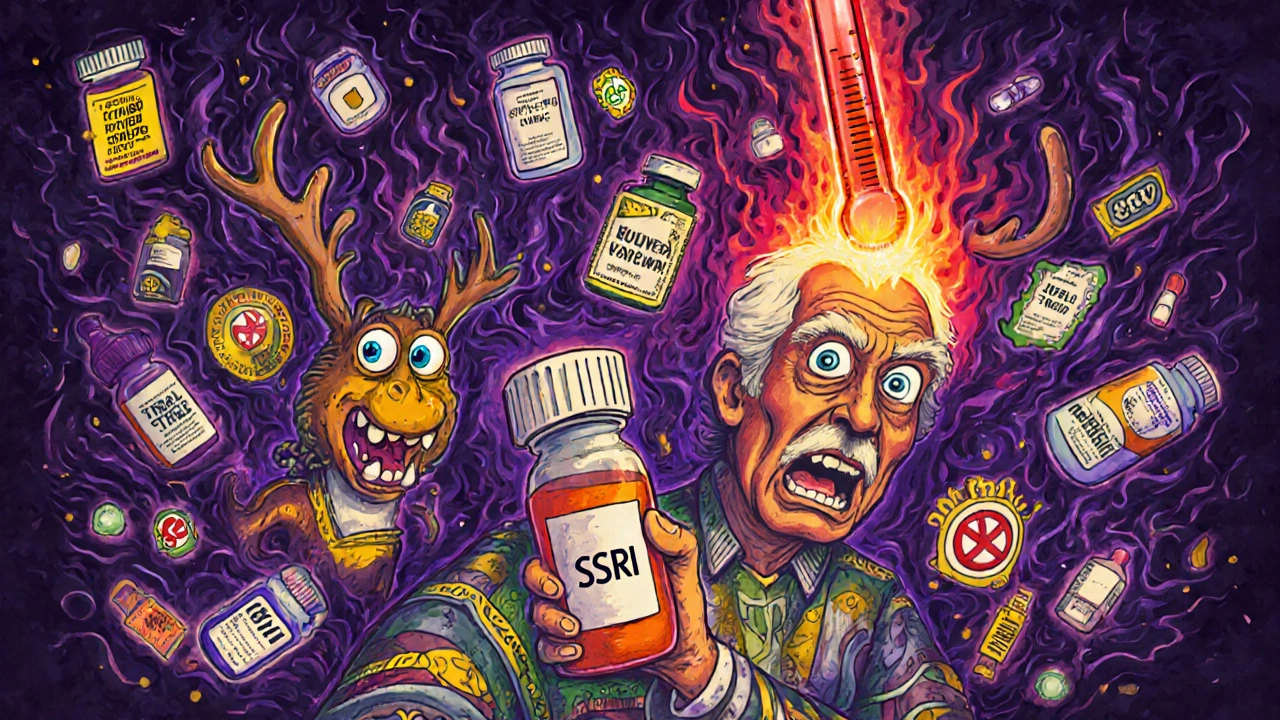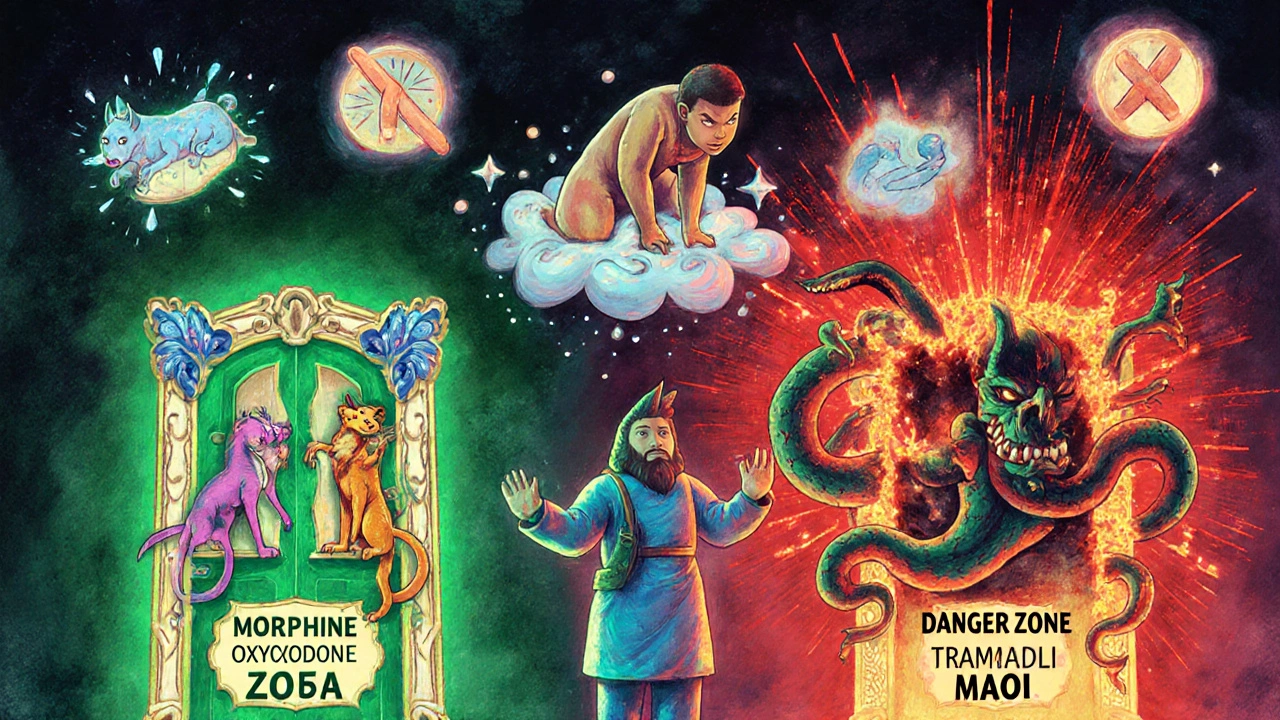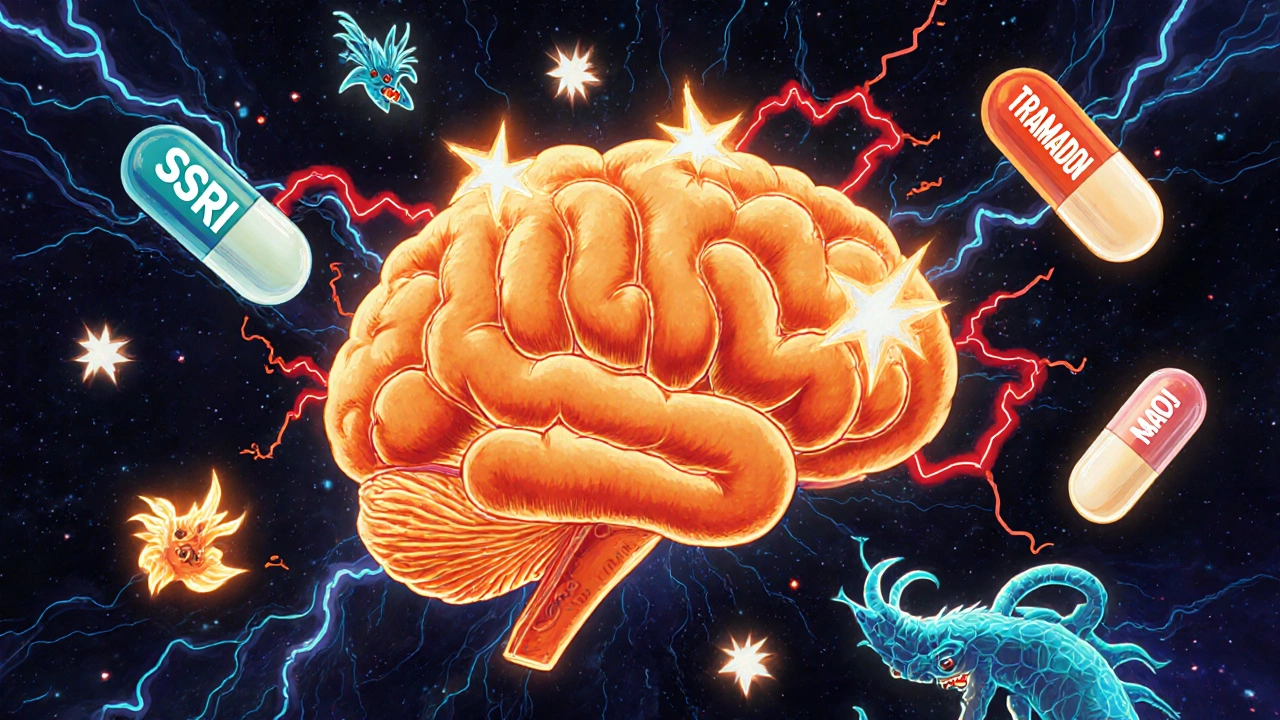More than 1 in 8 Americans take an SSRI antidepressant. That’s over 30 million people. Most do fine. But a quiet danger hides in plain sight - when these meds mix with other common drugs, the risk of serotonin syndrome spikes. And it’s not just rare. It’s serious. Sometimes deadly.
What SSRIs Actually Do
SSRIs - selective serotonin reuptake inhibitors - work by keeping serotonin active in your brain longer. Serotonin helps regulate mood, sleep, and anxiety. That’s why drugs like sertraline (Zoloft), escitalopram (Lexapro), and fluoxetine (Prozac) are prescribed for depression and anxiety. They’re safer than older antidepressants, but they’re not harmless. The problem isn’t the SSRI alone. It’s what happens when you add something else that also boosts serotonin.How Serotonin Syndrome Happens
Serotonin syndrome isn’t an allergy. It’s a toxic overload. Too much serotonin in your brain and spinal cord causes your nervous system to go haywire. Symptoms start fast - often within hours of mixing drugs. You might feel agitated, shaky, or sweaty. Your muscles lock up. Your temperature climbs. In severe cases, you develop seizures, lose consciousness, or go into organ failure. The Hunter Criteria are what doctors use to diagnose it. You need at least one of these: spontaneous muscle spasms, clonus (involuntary jerking) with fever or sweating, or high muscle tone plus fever and eye twitching. It’s not vague. It’s specific. And it’s often missed because symptoms look like the flu, heatstroke, or a panic attack.High-Risk Drug Combos You Need to Know
Not all drug interactions are equal. Some are red flags. Others are barely risky. Here’s what the data shows:- MAOIs - like phenelzine or selegiline - are the most dangerous. Mixing them with SSRIs can kill you. The mortality rate jumps to 30-50%. This combo is strictly forbidden.
- Linezolid - an antibiotic for stubborn infections - carries a 3x higher risk when taken with SSRIs. It’s not common, but it’s real. If you’re on an SSRI and need antibiotics, ask your doctor to avoid linezolid.
- Tramadol, dextromethorphan, and pethidine - these are opioids and cough meds you might not think of as risky. But they’re serotonin boosters too. Tramadol, especially, is a top offender. One study found it increases serotonin syndrome risk by nearly 5 times when combined with SSRIs.
- SNRIs - like venlafaxine (Effexor) or duloxetine (Cymbalta) - are also antidepressants. Taking them with SSRIs triples your risk. Many doctors still prescribe this combo, thinking it’s "safe." It’s not.
- St. John’s wort - a popular herbal supplement - has been linked to serotonin syndrome in dozens of case reports. People take it to "feel better," not realizing it’s chemically similar to an SSRI.
Meanwhile, morphine, oxycodone, and codeine? They’re generally safe to use with SSRIs. No major risk increase. That’s important for chronic pain patients.

Why Some People Are More at Risk
It’s not just about what you take - it’s about how your body handles it. Older adults are especially vulnerable. One in five Americans over 60 takes an SSRI. One in five also takes an opioid. And nearly a quarter take five or more medications daily. That’s a recipe for hidden clashes. Genetics play a role too. If you’re a poor metabolizer of CYP2D6 - a liver enzyme - your body can’t break down tramadol properly. That means more of it sticks around, flooding your system with serotonin. People with this genetic profile have 2.4 times higher risk when combining tramadol with SSRIs. And then there’s timing. Fluoxetine (Prozac) sticks around for weeks. Its active metabolite can linger for over two weeks after you stop taking it. If you switch from fluoxetine to an MAOI or linezolid without waiting at least five weeks, you’re playing Russian roulette with your nervous system.Real Cases, Real Consequences
A Reddit user named AnxietyWarrior87 described going from normal to hospitalized in 12 hours after adding tramadol to sertraline. Fever hit 104.2°F. Muscles locked. He needed three days in ICU. The FDA’s adverse event database recorded nearly 2,000 serotonin syndrome cases linked to SSRIs between 2018 and 2022. Over two-thirds involved drug combinations. One patient took St. John’s wort with Prozac for three days - then ended up in the ER with uncontrollable shaking and confusion. The doctor called it early serotonin syndrome. The Libby Zion case in 1984 changed medicine forever. An 18-year-old died after being given meperidine (a strong opioid) while on an MAOI. That case exposed how little doctors knew about drug interactions back then. It led to hospital reforms - and still, today, people are dying from the same mistakes.What Doctors and Pharmacies Are Doing About It
The American Psychiatric Association says: if switching from an SSRI to an MAOI, wait at least two weeks. For fluoxetine, wait five weeks. That’s not a suggestion. It’s a rule. Pharmacists are stepping up. A 2023 study found pharmacist-led medication reviews cut serotonin syndrome risks by 47% in Medicare patients. They catch the bad combos before they’re filled. Electronic health records are getting smarter. Epic Systems updated its alerts in 2022 and cut dangerous SSRI-opioid prescriptions by 32% across 200 hospitals. Now, if a doctor tries to prescribe tramadol to someone on sertraline, the system pops up: "High risk for serotonin syndrome. Consider alternative pain management."
What You Should Do
If you’re on an SSRI, here’s what to do right now:- Review every medication - including over-the-counter cough syrups, supplements, and herbal remedies. Dextromethorphan is in 100+ cold meds. St. John’s wort is in dozens of "mood support" pills.
- Ask your doctor: "Could any of my meds be raising my serotonin?" Don’t assume they know. Many don’t.
- Know the 5 S’s: Shivering, Sweating, Stiffness, Seizures (rare), Sudden confusion. If you get any two of these after starting a new drug, go to the ER.
- Don’t stop your SSRI cold turkey. Withdrawal can be brutal. Always taper under supervision.
- Use oxycodone or morphine instead of tramadol if you need pain relief. The risk difference is clear.
Most people on SSRIs will never have serotonin syndrome. But if you’re on multiple meds - especially if you’re over 60 - you’re in the danger zone. This isn’t fearmongering. It’s math. And it’s preventable.
What’s Next
The FDA is pushing for mandatory alerts in all e-prescribing systems by 2026. A blood test called SerotoninQuant is in trials - it might one day confirm serotonin syndrome objectively, instead of relying on symptoms. But until then, the solution is simple: awareness. Knowledge. Communication.SSRIs saved lives. But they’re not magic bullets. They’re powerful tools. And like any tool, they can hurt you if used carelessly.
Can I take tramadol with an SSRI?
No - not safely. Tramadol increases serotonin syndrome risk by nearly 5 times when combined with SSRIs. If you need pain relief, ask your doctor about oxycodone or morphine instead. They carry little to no added risk. Never combine tramadol with sertraline, fluoxetine, escitalopram, or any other SSRI without explicit medical approval.
How long should I wait after stopping an SSRI before starting an MAOI?
Wait at least two weeks after stopping most SSRIs. But if you were on fluoxetine (Prozac), wait five weeks. Fluoxetine and its active metabolite stay in your system for up to 15 days. Starting an MAOI too soon can trigger a fatal serotonin overload. Never skip this waiting period.
Is St. John’s wort safe with SSRIs?
No. St. John’s wort acts like an SSRI. Combining it with prescription antidepressants can cause serotonin syndrome. Many people take it thinking it’s "natural" and safe. It’s not. There are dozens of documented cases of ER visits from this combo. Avoid it completely if you’re on an SSRI.
What are the first signs of serotonin syndrome?
Look for sudden shivering, heavy sweating, muscle stiffness, restlessness, or confusion - especially after starting a new drug. These often appear within hours. If you notice two or more of these symptoms, seek emergency care. Don’t wait. Early treatment saves lives.
Can serotonin syndrome be fatal?
Yes. When caused by drug interactions - especially SSRIs with MAOIs or linezolid - serotonin syndrome can lead to high fever, seizures, organ failure, and death. The mortality rate for severe cases can reach 30-50%. Most deaths are preventable with proper drug screening and patient education.
Are SSRIs safe for older adults?
SSRIs can be safe for older adults, but the risk of dangerous drug interactions increases with age. Nearly 22% of Americans over 65 take SSRIs, and 18% use opioids. Many take five or more medications. That’s why pharmacists and doctors must carefully review all prescriptions. Never assume a new medication is safe - always ask about serotonin risks.

Douglas cardoza
November 23, 2025 AT 15:08I took sertraline for two years and never knew tramadol could be this dangerous. My cousin ended up in the ICU last year after mixing it with his Zoloft for back pain. He thought it was just a "stronger painkiller." No one warned him. This post saved my life.
Adam Hainsfurther
November 25, 2025 AT 02:31It’s wild how many people take St. John’s wort thinking it’s harmless because it’s "natural." I’ve seen friends do it while on SSRIs and laugh it off. But the science doesn’t lie. It’s literally the same mechanism as an SSRI. The FDA should require warning labels on every bottle. Not just in pharmacies, but on Amazon listings too.
Rachael Gallagher
November 25, 2025 AT 04:38Old people are dying because doctors are lazy and pharmacies don’t care. I’ve seen my grandma on 7 meds and no one checks for serotonin overload. She’s 72, on Lexapro and a cough syrup with dextromethorphan. They call it "polypharmacy" like it’s a buzzword, not a death sentence.
Nikki C
November 26, 2025 AT 20:20It’s not just about the drugs. It’s about how we treat mental health like it’s a switch you flip on and off. SSRIs aren’t candy. They’re chemical tools. And we treat them like they’re vitamins. We don’t educate people. We just hand out prescriptions and hope for the best. That’s not care. That’s negligence dressed up as compassion.
And then when someone gets sick? We blame them for not reading the label. But the label is buried in 12-point font next to a picture of a smiling sun.
Alex Dubrovin
November 28, 2025 AT 19:53My dad was on fluoxetine for 8 years. When he switched to an MAOI, his doctor said "just wait two weeks." I looked it up. It’s five. He almost died. Never trust a doctor’s memory. Always check yourself.
Jacob McConaghy
November 28, 2025 AT 22:49Pharmacists are the real heroes here. I had a pharmacist stop me from filling a tramadol script with my escitalopram. She pulled up the Hunter Criteria and showed me the numbers. I didn’t even know what serotonin syndrome was. She didn’t just say no-she explained why. That’s the kind of care we need more of.
Doctors are rushed. Pharmacies are understaffed. But when someone takes the time to actually help? It changes everything.
Natashia Luu
November 29, 2025 AT 22:42This is precisely why we must institutionalize mandatory pharmacogenetic testing before prescribing any psychotropic medication. The current system is archaic, reactive, and statistically indefensible. The fact that we are still relying on patient self-reporting and physician recall-rather than objective biomarkers-is a national disgrace.
It is not merely a medical oversight; it is an ethical failure of the highest order.
akhilesh jha
November 30, 2025 AT 21:58Tramadol is everywhere in India too. People buy it over the counter for headaches. No one knows what SSRIs are. But they take them anyway. My cousin’s mom died last year. No autopsy. Just "heart attack." We never knew it was serotonin.